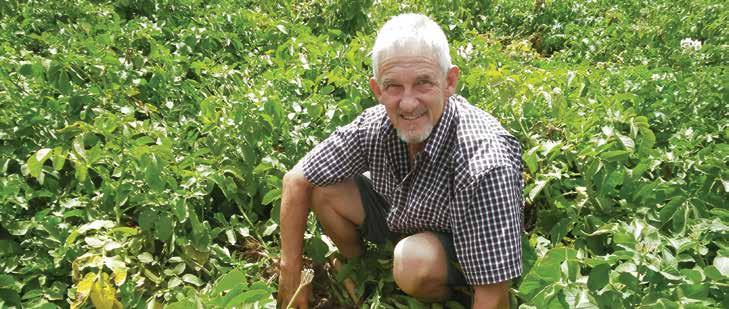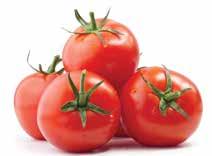
5 minute read
Nitrogen efficiency increased
NITROGEN EFFICIENCY
INCREASED
Words by Glenys Christian
Balle Brothers agronomist, Graham Bunckenburg, with a crop of Agria potatoes at Puni, outside Pukekohe
Pukekohe-based vegetable growers, Balle Brothers, knew they were performing quite well when it came to reducing nitrogen applications, but the soon to be completed Fluxmeter Network project showed how even more gains could be made.
“It was confirmation that we were on the right track,” says company agronomist, Graham Bunckenburg, who focuses on its potato crops. “All our thinking has been about using nitrogen more efficiently.” In their case that’s meant a move to reduce the base dressing to around 50% of the total going on, then apply up to three side dressings. “The last ones might not go on if they’re not needed,” he says. This has led to reducing nitrogen leaching from the soils potatoes are grown in to from 25 to 30 kilograms a hectare, with the impetus firmly there to reduce that even further. “We knew that with our main crop potatoes we were coming from a good base, but there are challenges.” “That’s where your agronomist skills come in.” He finds using nitrate Quick Test (QT) strips a good backup tool to fine tune the rate and timing of side dressings. “We don’t use it extensively but it’s there if we want it,” he says. “The trick is to get the minimum amount on in those side dressings.” A gradual improvement in nitrogen leaching levels has also been seen in soils where the company grows onions. “Wasted fertiliser is wasted money,” Graham says. “We’ve probably achieved the easy gains.”
But with seed quality, soil preparation, soil moisture levels and pest and disease threats all contributing to the final crop yield there’s a lot in the mix. An attack of potato blight, for example, can mean nitrogen is lost which would otherwise have gone into the growing crop. Balle Brothers is also acutely aware of the risk that bare land presents when it comes to leaching rates so has moved to growing a range of catch crops such as mustard, legumes or ryegrass to mitigate that. But there’s always the ever-present threat of a big rainfall event right between when potatoes or onions are harvested and the catch crop grows enough to hold nutrients in the soil.
The Fluxmeter Network project, which will wrap up this month (March), began back in 2014 with 12 sites chosen around the country on a range of cropping soils which were planted in a range of different crops in the years since. One of the sites was on a Balle Brothers’ property in the Waikato. The Foundation for Arable Research (FAR) led programme is mainly funded through the Ministry for the Environment’s Fresh Water Improvement Fund. Co-funders and collaborating partners are FAR, Horticulture New Zealand’s Vegetable Research and Innovation (VR&I) Board, Potatoes NZ and Ravensdown, along with local bodies Environment Canterbury as well as Horizons, Hawke’s Bay, Waikato and Auckland regional councils. Plant & Food Research is also collaborating with the project, building on a programme of work funded by the Ministry for Primary Industries’ (MPI) Sustainable Farming Fund (SFF). At each site 12 fluxmeters were installed with rainfall and irrigation measured, along with the total nitrate and phosphate concentrated in the drainage water to estimate losses. With good knowledge about the ability of different soils to supply nitrogen to the crop being grown as well as the crop’s requirements based on its predicted yield, it was hoped informed decisions could be made by growers about nitrogen applications. The results found that high losses were associated with high drainage volumes, and high nitrate concentrations in the drainage water meaning nitrogen losses from the root zone were also high. Losses over the five years showed a wide range, but at a number of the sites nitrate levels have now been reduced to below the drinking water standard. In most cases drainage losses occurred during the late autumn, winter and/or early spring months when rainfall and soil moisture content were highest. And at a number of the sites soil mineral nitrogen concentrations were high despite drainage losses being low, representing a high risk of loss. Cumulative phosphorus losses for the five years of trials continued to be low, but it was found there was some room for Olsen P levels to be improved, as well as reducing the risk of sediment movement and erosion due to wind and rain.

In a collaboration with another SFF project managed by FAR, a sediment trap was installed at a Hawke’s Bay site to measure run-off volumes and find out how effective different setback widths are on different slopes at filtering run-off water and trapping sediment. All the fluxmeter data has been made available to Overseer, with the Plant & Food Research modelling team now carrying out the calibration process and more vegetable crops being gradually added. Graham, who is a member of the Potatoes New Zealand Agronomy Advisory Group, is now involved in the Sustainable Vegetable Systems Project. This will further analyse nitrate uptake and nutrient leaching, with monthly monitoring of potato crops through soil testing at different levels and a full bio-assay being conducted.
ecolibriumbiologicals.nz WE WON’T BE BEATEN ON PRICE AND PERFORMANCE!
Heavyweight slug and snail control with a double-hit combo...
Knock out slugs and snails with new-generation Slug-em and new Dawn
Dawn is a highly-effective pelletised slug and snail killer. Once slugs and snails have fed on the pellet, the iron is released from its bound form in the gut, and is uniquely toxic to slugs and snails. Dawn can be used around vegetables, ornamentals and potted plants – seedlings or established plants.
Slug-em is a fast-acting, convenient liquid formulation containing natural tea saponin extracts. Slug-em removes the ‘slime’ layer from molluscs and leads to rapid dehydration and death, yet has an excellent safety profile for other species and has no withholding period.
Unit 4, 4 Austen Place, Pukekohe | Phone: 09 963 1834 contactus@ecolibriumbiologicals.kiwi
Dawn is registered pursuant to the ACVM Act 1997 No. P009704 Slug-em is registered pursuant to the ACVM act 1997 No. P008915 and to the HSNO Act 1996 approval code HSR100516










